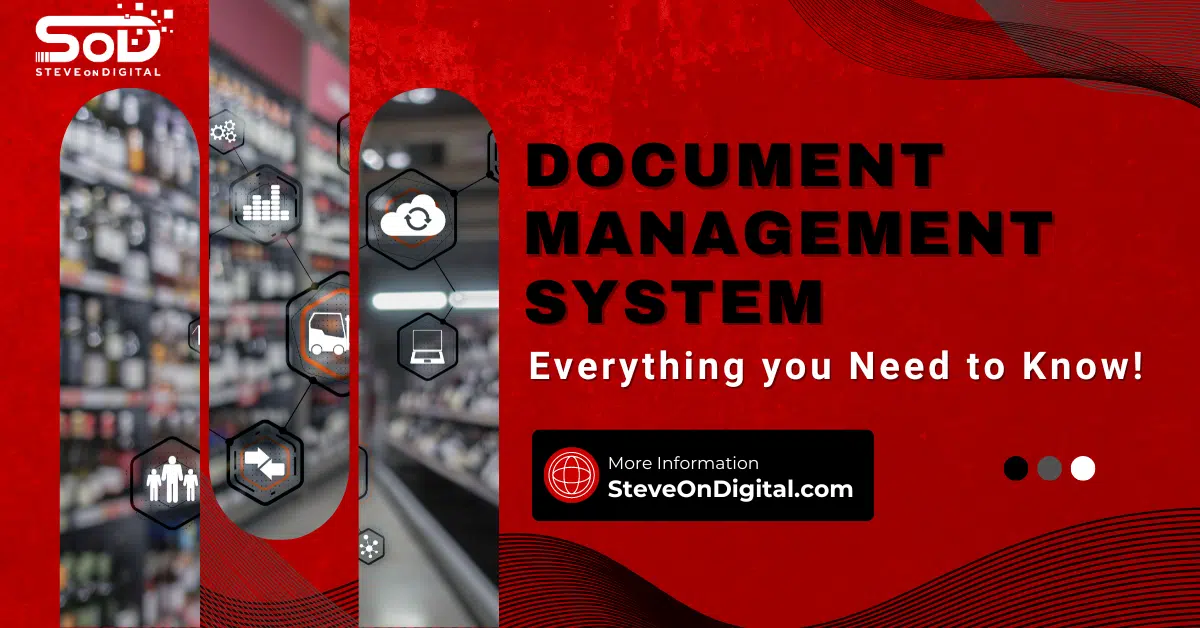A Document Management System (DMS) is a software solution that helps businesses manage, store, and track electronic documents. Selecting the best document management system is crucial for ensuring integration capabilities, data security, scalability, document search capabilities, mobile access, and cost comparison. By digitizing document handling processes, a DMS reduces reliance on physical storage and improves accessibility across the organization.
Document Management Systems (DMS) have become essential for modern businesses, enabling efficient handling, storage, and retrieval of electronic documents. Transitioning from traditional paper-based systems to advanced electronic solutions enhances productivity and ensures data security.
I’m Steve, a digital transformation expert with a strong background in electrical engineering, an MBA, and a master’s in Project Management. I excel at helping SMEs navigate the digital landscape with practical insights. Let’s begin!
What Is A Document Management System?
Definition of Document Management System
A Document Management System (DMS) is a comprehensive document management solution that includes document life cycle control, metadata, access control, and integration with other business solutions. By digitizing document handling processes, a DMS reduces the reliance on physical storage and improves information accessibility across the organization.
History of Document Management Systems
The evolution of document management began with filing cabinets in the late 1800s. The advent of computers in the 1980s marked the beginning of electronic document management, which further evolved with the introduction of scanners and personal computers. Today, cloud-based DMS solutions dominate the market, offering enhanced flexibility and accessibility (TinyMCE) (Axero Solutions).
Types of Document Management Systems
There are three main types of DMS:
- Cloud-Based DMS: These systems store documents on remote servers, allowing access from anywhere with an internet connection.
- On-Premises DMS: Installed on a company’s local servers, offering complete control over data.
- Hybrid DMS: Combines elements of both cloud-based and on-premises systems, providing flexibility and control (Axero Solutions).
| Type of DMS | Description | Advantages |
| Cloud-Based | Stores documents on remote servers, accessible via internet. | Flexible access, reduced IT costs, easy scalability. |
| On-Premises | Installed on local servers, providing complete control over data. | Enhanced security, full control over data management. |
| Hybrid | Combines elements of both cloud-based and on-premises systems. | Flexibility, control, and scalability. |
Key Features of Document Management Systems
Document Capture and Indexing
Document capture involves converting paper documents into electronic formats through scanning. Indexing allows these documents to be easily searchable, often using metadata to classify and organize them efficiently.
The best document management systems offer advanced features like optical character recognition for scanning documents and automated metadata for organizing files.
Version Control
Version control tracks changes to documents, ensuring users can access and revert to previous versions. This feature is crucial for maintaining document integrity and collaboration.
Access Control and Permissions
Access control in an effective document management system restricts document access based on user roles, ensuring sensitive information is only available to authorized personnel.
Search and Retrieval
Effective search and retrieval capabilities allow users to find documents quickly using keywords or metadata, significantly improving workflow efficiency (business.com).
Benefits of Using Document Management Systems
Improved Efficiency and Productivity
DMS streamlines business processes by automating document handling, reducing the time spent on manual tasks and enabling employees to focus on more critical activities.
Enhanced Security and Compliance
DMS offers robust security features, including encryption and access controls, to protect sensitive data. It also helps businesses comply with regulations by providing audit trails and secure document storage.
Cost Savings
By reducing the need for physical storage and minimizing document retrieval times, DMS helps businesses save on operational costs (TinyMCE) (Fit Small Business).
| Benefit | Description |
|---|---|
| Improved Efficiency and Productivity | Automates document handling, reduces manual tasks, and enables focus on critical activities. |
| Enhanced Security and Compliance | Provides encryption, access controls, and audit trails to protect data and ensure compliance. |
| Cost Savings | Reduces need for physical storage and minimizes document retrieval times, saving operational costs. |
Document Management Software Features
Collaboration Tools
Modern DMS includes collaboration tools with essential file sharing capabilities, allowing users to easily share files and folders, manage access rights, and collaborate effectively with internal and external stakeholders. This enables multiple users to work on documents simultaneously, fostering teamwork and improving project outcomes.
Workflow Automation
Workflow automation features streamline routine tasks, such as document approval processes, reducing manual intervention and speeding up operations.
Integration with Other Systems
DMS can integrate with other business systems like Customer Relationship Management (CRM), project management tools, and Enterprise Resource Planning (ERP), ensuring seamless data flow across platforms (Axero Solutions) (business.com).
Choosing the Right Document Management System
Choosing the right Document Management System (DMS) is crucial for any business. Here’s a detailed guide to help you make the best decision for your needs.
Assessing Business Needs
When considering a DMS, start by assessing your business needs. The size of your business and the nature of your documents play a significant role in this decision. For small businesses, it’s essential to choose a system that offers scalability and can grow with your company. Additionally, consider the following factors:
- Document Volume: Estimate the volume of documents you handle daily.
- User Requirements: Determine the number of users and their access needs.
- Integration Needs: Identify which existing systems (like CRM or ERP) need integration with the DMS.
- Security Requirements: Evaluate the level of security required for your documents.
From my experience, small businesses often underestimate their document volume and user requirements, leading to a mismatch in DMS capabilities.
Comparing DMS Providers
Once you have a clear understanding of your needs, compare different DMS providers. Many document management systems offer free trials for testing, mobile functionality through dedicated apps or web browsers, and integration with e-signature tools. Here are some criteria to consider:
- Ease of Use: Ensure the system is user-friendly. A steep learning curve can hinder adoption.
- Feature Set: Look for key features such as version control, collaboration tools, and document capture.
- Customer Support: Reliable customer support is vital. Check for available support channels like phone, email, and chat.
- Reviews and Ratings: Research reviews and ratings from other users. Websites like G2 and Capterra can provide valuable insights.
I once chose a DMS that seemed perfect on paper but failed in real-world use due to poor customer support. Learning from that experience, I now prioritize support alongside features.
Cost Structure
Understanding the cost structure of various DMS options is essential. Costs can vary widely based on features and scalability. Consider:
- Subscription Fees: Most DMS providers offer subscription-based pricing. Ensure it fits within your budget.
- Additional Costs: Be aware of any extra charges for additional users, storage, or advanced features.
- Long-term Costs: Consider the long-term costs, including potential upgrades or add-ons.
For instance, I once found a low-cost DMS appealing but later discovered hidden fees for necessary features, which made it more expensive in the long run.
| Consideration | Description |
|---|---|
| Document Volume | Estimate the number of documents handled daily. |
| User Requirements | Determine the number of users and their access needs. |
| Integration Needs | Identify existing systems (CRM, ERP) that need integration with the DMS. |
| Security Requirements | Evaluate the level of security required for your documents. |
Implementing a Document Management System
Implementing a DMS involves several critical steps to ensure a smooth transition.
Planning and Preparation
Proper planning is the foundation of a successful DMS implementation. Identifying business drivers and expected returns from investments in document management solutions is crucial. Here are key steps to take:
- Set Clear Objectives: Define what you aim to achieve with the new system.
- Develop a Timeline: Create a realistic timeline for the implementation process.
- Allocate Resources: Ensure you have the necessary resources, including budget and personnel.
In my experience, having a clear plan helped avoid delays and ensured a smooth transition.
Data Migration
Migrating existing documents to the new DMS is a critical step. Follow these guidelines:
- Inventory Documents: Create an inventory of all documents to be migrated.
- Choose a Migration Method: Decide whether to use manual or automated migration.
- Test the Migration: Perform a test migration to identify potential issues.
During a past project, I faced data loss due to inadequate testing. Ensuring thorough testing can prevent such issues.
User Training and Support
Training users and providing ongoing support is vital for successful adoption. Consider these steps:
- Create Training Programs: Develop comprehensive training programs tailored to different user roles.
- Provide Documentation: Offer user manuals and online resources.
- Offer Continuous Support: Ensure ongoing support through help desks or support teams.
I’ve found that continuous support significantly improves user adoption and satisfaction.
Best Practices for Document Management
Implementing best practices ensures that your DMS operates efficiently and effectively.
Organizing Documents
Organizing and categorizing documents effectively is essential. Here are some methods:
- Use a Clear Folder Structure: Create a logical and consistent folder structure.
- Tag Documents: Use tags or metadata to make documents easily searchable.
- Regularly Update Categories: Review and update categories as needed.
A well-organized system saves time and reduces frustration.
Maintaining Document Integrity
Ensuring the integrity and authenticity of documents is crucial. Follow these guidelines:
- Use Version Control: Implement version control to track document changes.
- Restrict Access: Limit access to sensitive documents to authorized personnel only.
- Regular Backups: Perform regular backups to prevent data loss.
Maintaining document integrity builds trust and reliability.
Regular Audits and Reviews
Conduct regular audits to ensure system efficiency. Here’s how:
- Schedule Audits: Perform scheduled audits to review document management processes.
- Analyze Results: Analyze audit results to identify areas for improvement.
- Implement Changes: Make necessary changes based on audit findings.
Regular reviews keep the system efficient and up-to-date.
Common Challenges and Solutions in Document Management
Implementing a DMS can come with challenges. Here are some common issues and their solutions.
Data Security Concerns
Data security is a top concern for many businesses. Address these issues by:
- Implementing Encryption: Use encryption to protect sensitive information.
- Regular Security Updates: Keep the system updated with the latest security patches.
- Conducting Security Audits: Regularly audit security measures to identify vulnerabilities.
In my experience, regular audits have helped identify and mitigate potential security risks.
User Adoption
Encouraging user adoption can be challenging. Here are some tips:
- Involve Users Early: Engage users early in the implementation process.
- Provide Training: Offer comprehensive training programs.
- Gather Feedback: Collect and act on user feedback to improve the system.
Involving users early and gathering feedback ensures higher adoption rates.
System Scalability
Ensuring the DMS can scale with business growth is essential. Consider these strategies:
- Choose a Scalable System: Select a DMS that can grow with your business.
- Plan for Growth: Plan for future growth during the initial implementation.
- Regularly Review Needs: Regularly review and adjust the system to meet changing needs.
Planning for scalability avoids future disruptions.
Industry-Specific Applications of DMS
Healthcare
In healthcare, Document Management Systems (DMS) play a crucial role in managing patient records and ensuring compliance with regulations like HIPAA. A DMS enables healthcare providers to securely store, retrieve, and share patient information, leading to improved patient care and operational efficiency. With electronic documents, medical professionals can access patient records quickly, facilitating timely decision-making. Additionally, DMS helps in maintaining audit trails, which are essential for compliance and quality assurance (TinyMCE) (Axero Solutions).
Legal
For legal professionals, managing case files and legal documents efficiently is paramount. A DMS allows law firms to organize large volumes of documents, making it easier to track and retrieve information when needed. Features like version control ensure that only the most current documents are used, reducing the risk of errors. The ability to store documents digitally also aids in collaboration, as multiple legal professionals can access and work on the same document simultaneously (business.com) (Fit Small Business).
Finance
In the finance industry, Document Management Systems are essential for handling sensitive financial documents and ensuring regulatory compliance. Financial institutions can use DMS to store documents securely, track changes, and manage permissions to restrict access to sensitive information. The automation of workflow processes within a DMS can also streamline operations, such as loan processing and auditing, thereby enhancing productivity and reducing manual errors (Axero Solutions) (business.com).
Advanced Features in Modern Document Management Systems
Optical Character Recognition (OCR)
Optical Character Recognition (OCR) is a significant feature in modern DMS that converts scanned paper documents into editable and searchable digital files. This technology enhances the efficiency of document management by making it easier to index and retrieve documents based on their content. By digitizing paper documents, businesses can save time and reduce physical storage needs. I’ve personally seen how OCR can revolutionize document handling, especially in industries like healthcare and finance, where quick access to information is critical (Axero Solutions) (business.com).
Artificial Intelligence and Machine Learning
Artificial Intelligence (AI) and Machine Learning (ML) are transforming document management by automating routine tasks and enhancing data analysis. AI-powered DMS can categorize documents, suggest tags, and even identify anomalies or errors in documents. This not only saves time but also improves accuracy. For instance, I’ve implemented AI-based DMS solutions that significantly reduced the time spent on document classification and retrieval, leading to more efficient business processes (Axero Solutions) (business.com).
Mobile Access and Remote Work
With the rise of remote work, having mobile access to documents is more important than ever. Modern DMS solutions offer robust mobile apps that allow users to access, edit, and share documents from anywhere. This flexibility ensures that employees can remain productive even when they are not in the office. In my experience, implementing a DMS with strong mobile capabilities has been a game-changer for enabling remote work and ensuring business continuity during disruptions like the COVID-19 pandemic (Axero Solutions) (business.com).
Additionally, offline access is a critical feature for users, allowing them to access documents even without an active internet connection.
Future Trends in Document Management Systems
Cloud-Based Solutions
Cloud-based Document Management Systems are becoming increasingly popular due to their scalability, cost-effectiveness, and accessibility. These systems allow businesses to store documents on remote servers, making them accessible from any location with an internet connection. The adoption of cloud-based DMS is expected to grow significantly, driven by the need for remote work solutions and the benefits of reduced IT infrastructure costs (TinyMCE) (Axero Solutions) (business.com).
Blockchain for Document Management
Blockchain technology offers potential uses in document management by providing secure, immutable records of document transactions. This can enhance document security and integrity, making it particularly useful in industries that require high levels of trust and transparency, such as finance and legal. While still in its early stages, the integration of blockchain with DMS could revolutionize how businesses manage and verify documents (TinyMCE) (Axero Solutions).
Increased Use of Automation
The future of document management lies in increased automation. Automated workflows can handle repetitive tasks such as document routing, approval processes, and notifications, freeing up employees to focus on more strategic activities. Automation also reduces the risk of human error and ensures consistent document handling practices. I’ve seen firsthand how automation in DMS can streamline operations and improve overall efficiency, making it an essential trend to watch (TinyMCE) (Axero Solutions).
Final Thoughts
Document Management Systems are vital tools for modern businesses, offering numerous benefits such as improved efficiency, enhanced security, and significant cost savings. As technology continues to evolve, the integration of advanced features like AI, OCR, and blockchain will further enhance the capabilities of DMS. Adopting a robust DMS can help businesses stay competitive, ensure regulatory compliance, and facilitate remote work. I encourage all businesses, especially small ones, to consider investing in a modern DMS to streamline their document management processes and support their growth.
By staying informed about the latest trends and best practices in document management, businesses can make more informed decisions and leverage the full potential of these powerful systems.




